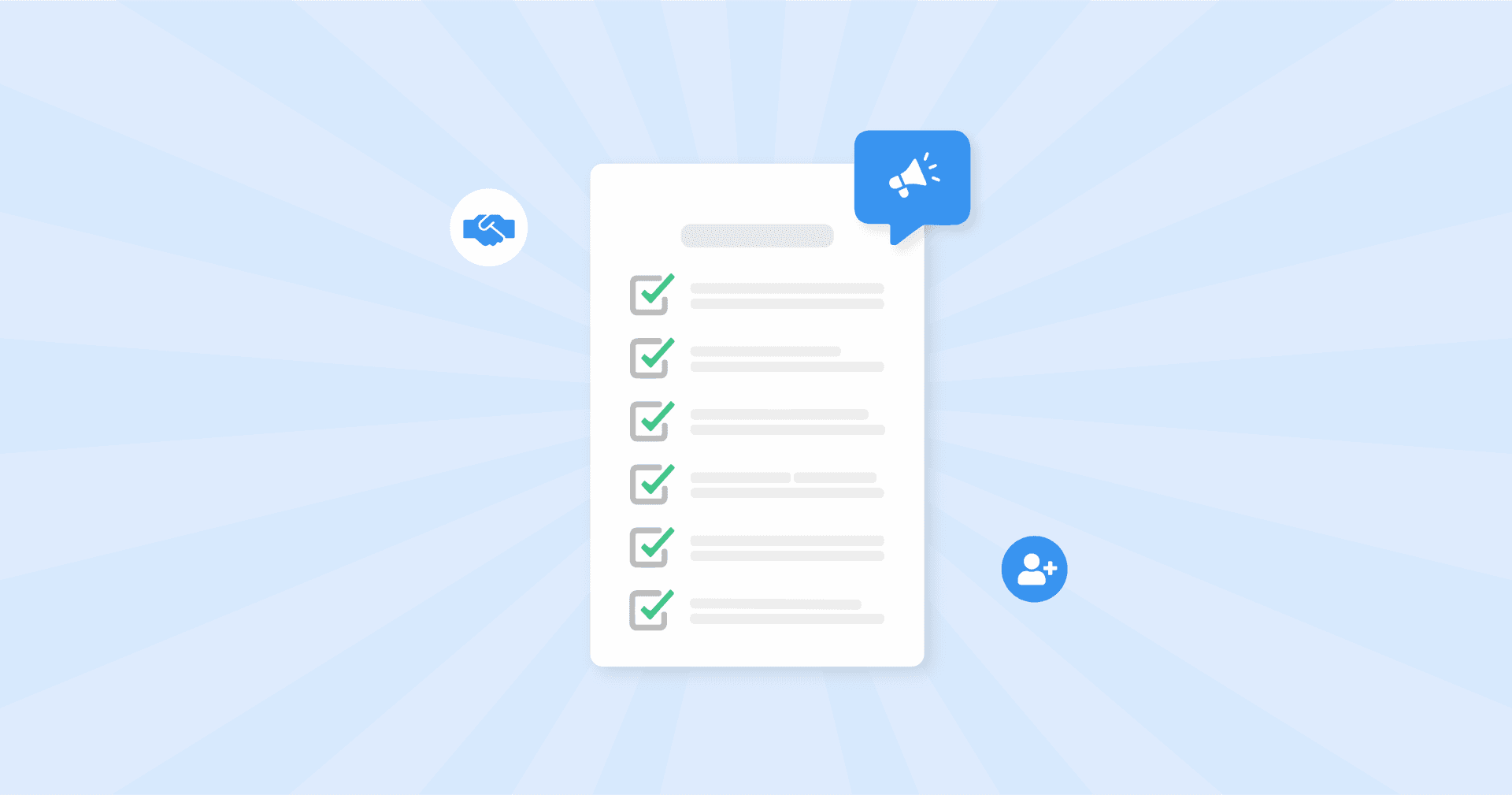Table of Contents
QUICK SUMMARY:
Agency project management ensures projects are executed efficiently, delivered on time, and meet client expectations. It involves using project management software to organize tasks, monitor progress, and allocate resources effectively.
Without successful project management, even the most thriving agency occasionally spirals into chaos.
Picture this–it’s a busy Monday morning. Your open-plan office is buzzing with the sounds of keyboard clicks, coffee brewing, and ringing phones.
As you’re heading to the first meeting of the day, you walk over to chat with your Project Manager. Just as they’re about to give project updates, the unthinkable happens–their Excel workbook crashes.
Suddenly, there are no project timelines, client feedback notes, or key performance indicators to review. What happens now? Manual data re-collection, frantic calls to clients, and wasted billable hours.
Having a proper project management system is a buffer to all of these issues. Not only does it provide a scalable framework as your agency grows, but it also creates a system to ensure client projects are delivered on time.
In this article, we’ll explore everything you need to know about effective agency management and how to improve your current processes.
The Importance of Agency Project Management
Project management isn’t just a buzzword term–it can be the difference between success and failure for many agencies. It plays a central role in managing multiple client projects, delivering results within pre-set timelines, and ensuring client satisfaction.
Without effective project management, it’s easy to miss important pieces, and the team starts to cut corners. It helps us deliver their projects on time, within budget, and to our clients’ required quality standards. It’s essential for competitiveness and long-term success.
Alejandra Villarreal, COO of Website Depot
To put it simply, project management helps agencies:
Streamline client management by organizing projects through pre-defined phases. This structured approach is essential to:
Create visual timelines, including a financial management plan
Decide on dates to send progress reports
Factor in regular 1:1 meetings with clients to discuss recommendations or challenges
Reduce scope creep (i.e., taking on project tasks without factoring in additional costs and resource management)
Ensure adequate resource planning and build a winning team. By doing so, it becomes easier to:
Assign tasks to staff members and create a realistic workload
Identify whether additional in-house hires are needed (e.g., a full-time agency project manager to coordinate an influx of new work)
Decide on effective agency pricing (e.g., estimating the time your staff takes to complete each project cycle and billing accordingly)
Onboard seasonal hires for a short-term or specialized project (e.g., getting a freelance website developer to write code for a client’s website update)
5 Project Management Frameworks for Agencies
Agency project management gets complex quickly. Without a structure in place, it’s easy to overwhelm your staff with too many deliverables, overlook important deadlines, or miss a client’s urgent request.
No need to wing it. Here are five popular project management methods to explore and explanations of how they apply to agencies.
1. The Waterfall Model
This project management methodology follows a linear sequence and consists of pre-defined stages. As the name suggests, each phase “waterfalls” into the other, which means you must complete one stage before advancing to the next.
Applying the Waterfall model means:
Understanding your client’s campaign requirements and clearly defining what success looks like
Creating a comprehensive strategy organized by project phases, including key components like:
A completion timeline (along with milestones at each phase)
Resource management
Which marketing channels will be used
Conceptualizing any marketing collateral (e.g., graphics, ad copy), which may require client approval before advancing to the next phase
Clearly communicating any caps in client revisions after sign-off to emphasize that the previous project phase work is final. This should be a clause in your client’s contract
Executing your client’s project and tracking progress over time
Evaluating success upon completion, which provides more insights for future projects
Pros and Cons of the Waterfall Method
Like any other project management methodology, the Waterfall Method has distinct pros and cons–let’s explore further.
Pros | Cons |
|---|---|
Ideal for client projects with well-defined goals and minimal expected changes | Challenging to revisit a previously completed stage, as it may affect the overall project flow or outcome |
Defines a sequential roadmap for project execution and completion, which keeps clients and agencies on the same page | Because clients are looped in at later phases, there may be requests or changes. This could mean more time expended and project delays |
Completing one phase at a time streamlines focus and removes the hassle of juggling multiple tasks at once
| If different agency teams are involved at each phase (e.g., the graphics and media buying teams), there may be internal siloes, reduced team collaboration, and increasing miscommunication |
Agency Use Cases of the Waterfall Method
To understand how this project methodology works in action, here are two use cases:
Developing a Social Media Content Calendar
Content Strategy: Develop a content strategy based on your client’s project goals and target audience
Content Planning: Plan content for the upcoming months, including post topics, imagery, and scheduling
Content Creation: Produce these deliverables, including graphics, videos, and written posts
Client Review: Share the content calendar with your client for review and approval
Scheduling and Posting: Share this content on social media according to the approved calendar
Monitoring and Analytics: Track social media engagement and provide periodic reports to your client
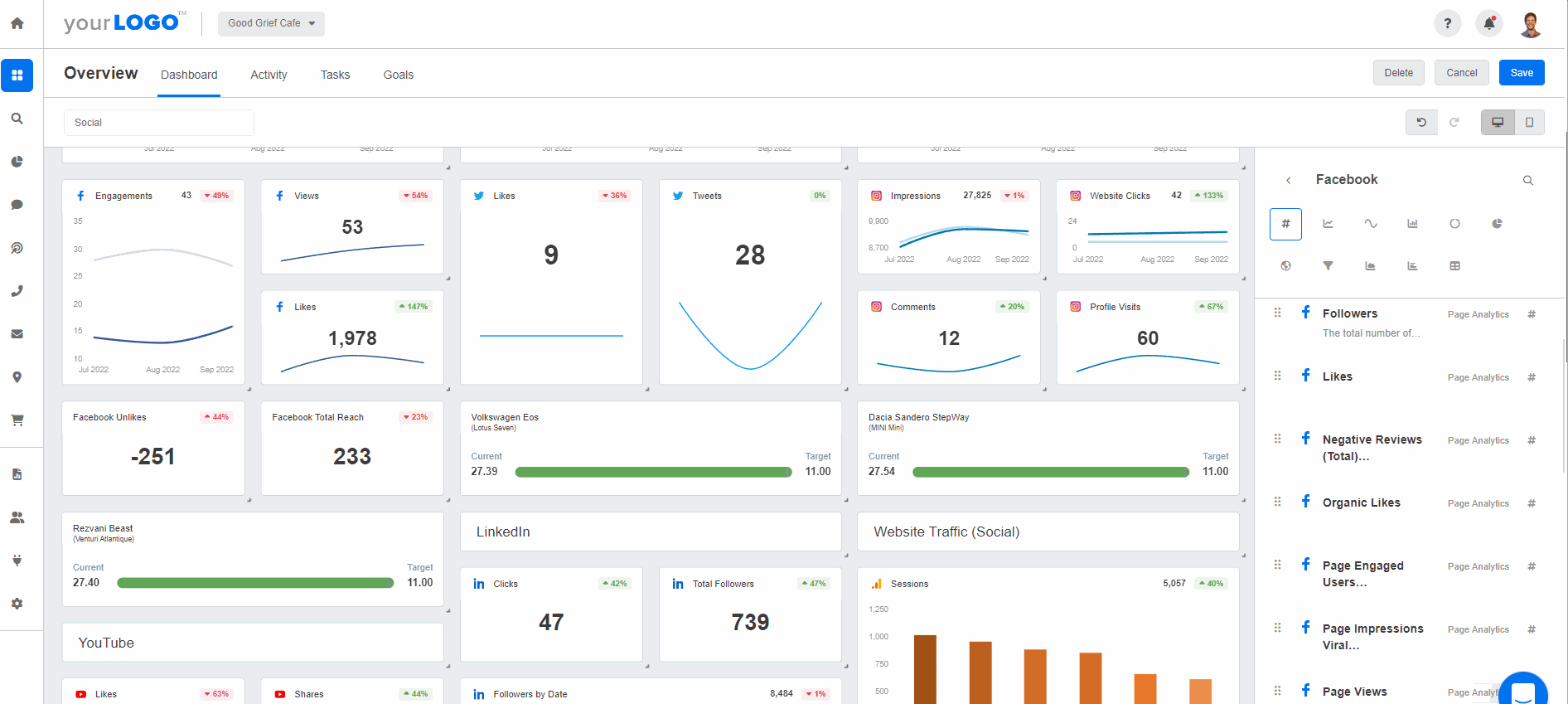
Keep on the pulse of your clients’ social media metrics and report on overall marketing progress. Invest in an efficient reporting system and help clients meet their goals–start your free 14-day AgencyAnalytics trial today.
Executing an Email Marketing Campaign
Campaign Strategy: Define your client’s email marketing objectives, target audience, and messaging
Content Creation: Populate email templates, write email copy, and design graphics
List Segmentation: Segment your client's email list based on demographics, behavior, and preferences
Client Approval: Share a preview of the email campaign with your client for feedback and approval
Deployment: Send your client’s email campaign to a segmented list
Analytics and Reporting: Provide a comprehensive email marketing report that includes metrics like open rates, click-through rates, and conversion rates
2. The Agile Methodology
As the name suggests, the Agile Methodology is a flexible and iterative approach to agency project management. Instead of focusing on a sequential order for project delivery (like the Waterfall Method), the Agile methodology:
Includes iterative testing at regular intervals before the completion of your client’s project
Factors in adaptability and change, which are often difficult to incorporate with the Waterfall method. That means previously completed work can be revisited if any unprecedented changes come up (e.g., Google algorithm changes)
Emphasizes continuous collaboration, which keeps clients and agencies on the same page. This may look like:
Scheduling internal meetings where your staff shares progress on their deliverables and any challenges
Having regular client check-ins to get feedback and make improvements. Because clients are looped in early, their iterations contribute to the quality of the overall end product
Pros and Cons of the Agile Methodology
When applied to an agency, the Agile methodology introduces new ways to manage campaigns, projects, and client relationships.
Here are the pros and cons to consider.
Pros | Cons |
|---|---|
Allows adaptation to any evolving marketing conditions or client changes | Continuously looping in clients may mean sharing premature results that didn’t get enough time to materialize (e.g., SEO efforts) |
Easier to launch smaller test campaigns to analyze performance and refine strategies (instead of waiting for a full-scale launch) | Possible to lose sight of broader campaign goals while focusing on perfecting and iterating short-term tasks |
Regular check-ins ensure that campaigns and final results meet client expectations | Because of its fluid approach, it may be more challenging to estimate billable time and provide fixed quotes to clients |
Agency Use Cases of the Agile Methodology
To understand how the Agile methodology works for agencies, here are two relevant examples.
A Website Redesign Project
Imagine that a client needs to revamp their website. Instead of doing a complete overhaul at once, use the Agile project management approach to:
Redesign high-priority pages or features
Launch the initial changes
Gather user feedback (e.g., organic traffic numbers)
Conduct A/B tests and optimize the content before moving along to update the remaining pages
Creating an SEO Strategy
Let’s say your client wants to improve their organic search rankings. Here’s what an Agile approach looks like:
Prioritize a list of keywords based on your client’s goals
Optimize content around these keywords and share campaign progress in monthly sprints
At the end of each iteration interval, analyze ranking improvements and adjust your client’s strategy for the next set of keywords

Track progress of large-scale SEO projects alongside related insights like PPC and social media analytics. Give clients real-time data through intuitive, visual dashboards–try AgencyAnalytics today, free for 14 days.
3. Hybrid Project Management
Want the best of the Agile and Waterfall methodologies? A Hybrid project management approach offers the best of both worlds—structure and flexibility. It's well-suited for projects where there's a need for strategic planning but also allows room for adaptability where needed.
We use a combination of Agile and Waterfall methodologies called "Agifall." This hybrid approach allows us to plan against the project’s scope yet remain agile enough to pivot our strategy as needed. We aim to create room for internal flexibility and collaboration while also creating a structured experience for our external stakeholders.
Jordan Jackson, Sr. Service Delivery Strategist at OTM
This blended approach:
Provides the structure of the Waterfall method by:
Creating sequential and well-defined project stages
Using these milestones as opportunities to check in with clients
Provide detailed progress reports at the end of each phase
Maintains the flexibility of the Agile methodology by:
Setting aside time for team collaboration and regular discussions about project progress
Evolving goals if there are any significant developments (e.g., a reduced project budget because of a recession)
Iterating at regular intervals and getting client feedback to ensure a more refined end product
Pros and Cons of the Hybrid Methodology
While it’s a comprehensive approach, the Hybrid methodology comes with its own set of pros and cons. Here's a quick rundown.
Pros | Cons |
|---|---|
Sets clearly defined milestones while remaining adaptable to any changes (e.g., external market conditions, client requests) | Requires a clear understanding of when and how to apply each aspect of the methodologies, which could be challenging |
Ability to customize your agency project management approach based on individual campaign requirements | May require internal staff training to implement, leading to additional cost and time investments |
Incorporating more frequent touchpoints keeps clients in the loop at earlier project phases | Potential limitations when searching for an agency project management tool that supports this methodology |
Agency Uses Cases of the Hybrid Methodology
Implement the Hybrid methodology by referencing the use case examples below.
Research and Data Projects
Scenario: A client needs market research for a product launch, followed by a series of data-driven marketing initiatives
Hybrid Application: Conduct research by clearly outlining stages for data collection, analysis, and reporting. Once insights are gathered, use an Agile approach to implement a product launch strategy. At regular intervals, iterate based on user feedback and performance metrics
Integrated Marketing Campaigns
Scenario: Your agency needs to launch a multi-channel marketing campaign that involves content creation and digital advertising
Hybrid Application: Use the Waterfall method to outline your client’s multi-channel strategy, objectives, and project milestones. Use Agile processes to maintain flexibility when creating content and running A/B ad testing
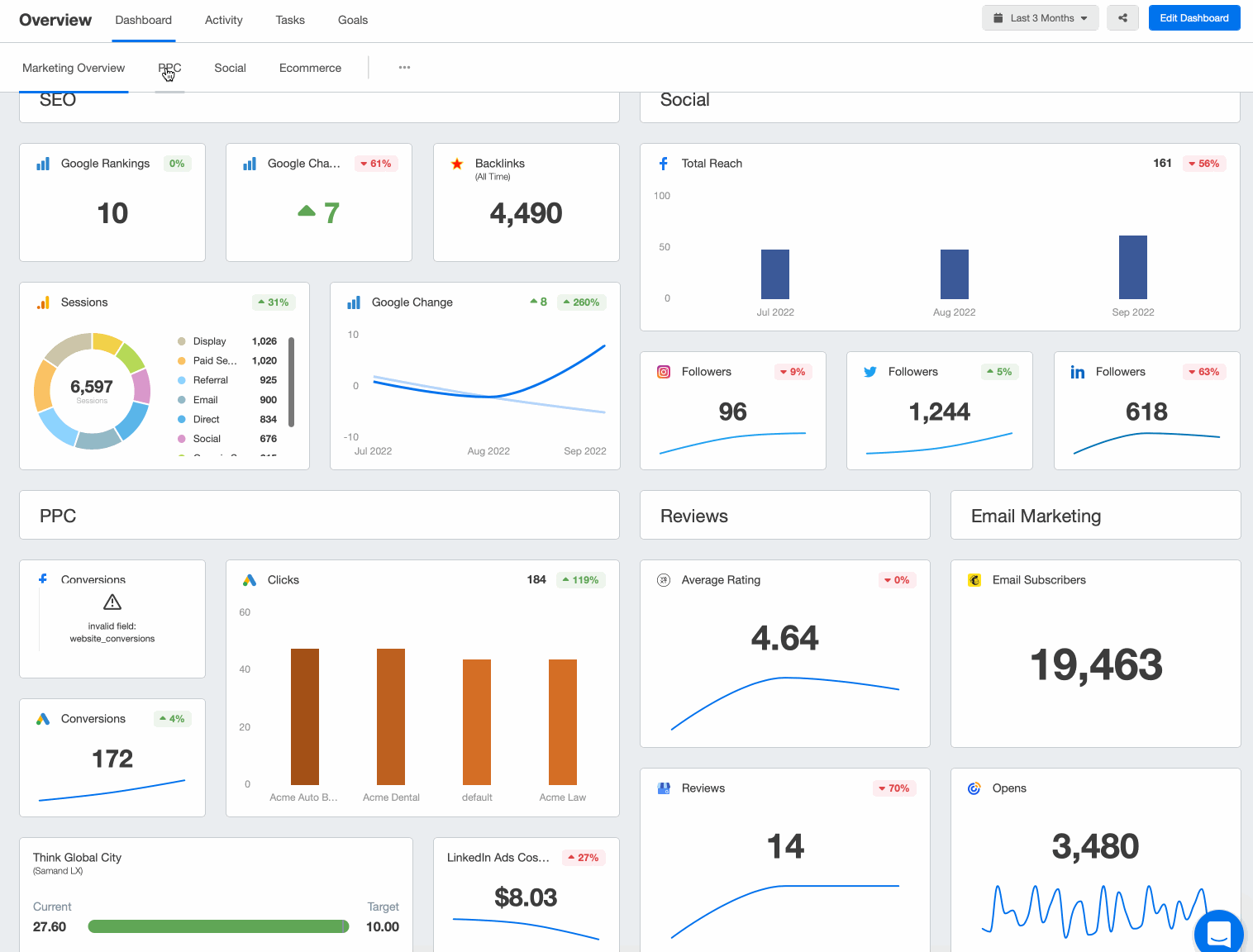
Got clients with multi-channel marketing campaigns? No need to toggle between platforms–automate data retrieval and stream insights into live, visual dashboards. Explore a range of pre-built templates on AgencyAnalytics, free for 14 days.
4. The Scrum Method
Think of the Agile methodology as an overarching philosophy.
The Scrum method is a framework that puts it into motion through pre-set guidelines and practices. That means an agency can be Agile without using Scrum, but if they're using Scrum, they’re inherently abiding by Agile principles.
While the Agile methodology focuses on broad values and recommendations, the Scrum method:
Defines specific roles for team members to increase accountability and task ownership. While the Scrum method’s role assignments are based on the software industry, here’s an overview of how it applies to agencies:
A Product Owner who focuses on task priority and maximizing ROI (e.g., a Client Account Manager with an understanding of all client projects)
A Development Team that is responsible for project execution and producing results (e.g., Content Specialists and Social Media Managers)
A Scrum Master who removes any roadblocks and ensures deadlines are met (e.g., your agency’s Project Manager who monitors timelines and keeps campaigns on track)
There is no perfect step-by-step process that can replace strategic assessment by a thoughtful human. Our Project Manager assesses what is being delivered against our strategy to ensure we are providing real value to our clients while also keeping things on time and within budget.
Jordan Jackson, Senior Service Delivery Strategist at OTM
Recommends the creation of a prioritized backlog. This means making a list of your client’s requested deliverables, assigning priority levels, and focusing on the ones that provide the most value for their current goals
Prescribes pre-defined sprints, which are check-in meetings that allow your staff to share deliverable progress and any roadblocks. Generally, sprints are scheduled every 2 to 4 weeks with a meeting agenda and closing reflections (e.g., sharing solutions to an encountered challenge when running PPC ads)
Pros and Cons of the Scrum Method
To get a better understanding of the Scrum methodology, here are a few things to consider.
Pros | Cons |
|---|---|
Regular check-ins mean identifying potential issues earlier, which reduces the chances of large-scale failures or late-stage revisions | Having too many sprints may mean more meetings and less time producing results |
Assigning roles results in more accountability, transparency, and task ownership | The Scrum Method’s role assignments may not align with your agency’s organizational structure |
Completing sprints and seeing tangible results may boost your team’s morale and provide a space for employee recognition | Some marketing tasks may take longer to complete, which may result in stagnant or repetitive sprints |
Agency Use Cases of the Scrum Method
Here are examples of how the Scrum Method works in an agency context.
Content Marketing Strategy for a Blog
First, create a backlog of priorities that includes blog topics, keyword research, and promotional tactics. The upcoming steps include:
Sprint Planning: Choose a topic and keywords to focus on for the upcoming blog
Weekly Sprint: Monitor writing progress, address any research challenges, and discuss promotional strategies
Sprint Review: Analyze website traffic, time spent on page, and reader engagement. Discuss high-level suggestions from your client
Retrospective: Identify what worked well, plans for the upcoming blog, and refine your client’s strategy accordingly
Social Media Campaign
After creating a backlog of campaign ideas, social media posts, and ad designs, follow these Scrum-inspired steps:
Sprint Planning: Decide on a priority (e.g., promoting a new product launch), and create the corresponding collateral (like graphics and ad copy)
Bi-weekly Sprint: At this meeting, internal team members share high-level details on the campaign and share content plans for the next two weeks
Sprint Review: Review the campaign's performance metrics, such as engagement rates, follower growth, and conversion rate. Share any feedback from the client
Retrospective: Discuss the effectiveness of the chosen strategies, platforms, and content types, and brainstorm improvements
5. The Lean Methodology
Derived from Toyota and their extensive experience in the manufacturing industry, the Lean methodology is all about maximizing efficiency and cutting down on waste.
While this may sound material, it may refer to other project aspects like time and resource management. In the context of agencies, this means:
Cutting down on overproduction (e.g., throwing in extra ad designs that a client didn't ask for)
Simplifying processes to maximize billable time (e.g., avoiding excessive edits to a completed and delivered blog post)
Reducing wait times where possible (e.g., requiring clients to meet deadlines for approvals)
Adequately resourcing client projects with appropriately skilled staff, which ensures you meet timelines and produce optimal results

Streamline task management, monitor your staff’s deliverables, and eliminate unnecessary overlaps –create your own task list on AgencyAnalytics, free for 14 days.
Pros and Cons of the Lean Methodology
Similar to other project management approaches, the Lean methodology has its strengths and weaknesses–here's a brief overview.
Pros | Cons |
|---|---|
Focuses on reviewing and improving processes, which results in maximum use of billable time
| Significantly trimming a project scope may stifle creativity, leading to compromised staff productivity |
Emphasizes tasks and deliverables that provide the most value. This increases ROI and may result in client loyalty over time
| An excessive focus on time optimization (e.g., providing strict deadlines for client feedback) may hurt agency-client relationships |
Having a more streamlined focus expedites project timelines and results in faster turnaround times | Oversimplified processes may not be applicable as you scale and move further along the agency life cycle |
Agency Use Cases for the Lean Methodology
Apply the Lean methodology by considering the use case examples below.
Client Onboarding Process
Before Lean: Your agency has a lengthy client onboarding process that includes redundant documentation and multiple meetings
With Lean: Your agency streamlines the onboarding process by consolidating documentation, creating a standardized onboarding toolkit, and scheduling a comprehensive kick-off meeting. This reduces the time to initiate projects and enhances the client experience
Campaign Reporting
Before Lean: Monthly reports are exhaustive, time-consuming, and often contain metrics that clients don't find valuable
With Lean: Your agency uses a client reporting tool to access pre-built templates (instead of creating manual copy-paste reports). Populating it with relevant KPIs or OKRs offers more actionable insights while reducing preparation time
How Agency Type Influences Project Management Style
Every marketing agency is unique. Whether it's client deliverables or service offerings, numerous differences and subtleties exist. To help you narrow options, here are examples of different agency types and suggested project management methodologies.
Remember–there’s no one-size-fits-all agency project management style. Use the following as guidelines, and don’t be afraid to try other options.
Full-service Agencies
Hybrid: Provides strong structure and flexibility, which comes in handy for handling a diverse range of client projects
Lean: Useful for testing new client services without being too time or resource-intensive (e.g., running a pilot with a small number of clients before launching full-scale services)
Public Relations Agencies
Agile: Ideal for PR campaigns that require adaptability due to rapidly changing news cycles, client needs, or evolving events
Scrum: Hones in on task management and allows regular check-ins for evolving PR events (i.e., periodic sprints based on your team’s schedule)
PPC Agencies
Waterfall: Works well for well-defined, large-scale projects that work in sequential order (e.g., large-scale programmatic advertising campaigns)
Agile: Useful for smaller advertising campaigns that require frequent iterations (e.g., optimizing Google Ads)
SEO Agencies
Agile: An adaptive approach that complements the evolving nature of SEO (e.g., Google algorithm changes that affect search visibility)
Hybrid: Ideal for large-scale SEO projects. For example, creating a long-term website marketing strategy may align with a structured Waterfall approach. However, for tactical aspects (like monthly blog creation), Agile allows a greater degree of flexibility
Event Marketing Agencies
Waterfall: Offers a defined approach, which is essential for large-scale events with fixed timelines (e.g., planning a time-sensitive media briefing)
Scrum: Useful for managing multiple projects and deciding on priorities
Branding or Creative Agencies
Waterfall: Ideal for complex campaigns (e.g., redesigning a client’s branding identity). Helps to reduce or eliminate extensive revisions after receiving client approval, which is often a challenge for creative agencies
Scrum: Working in sprints and seeking continuous feedback (both internally and from clients) refines and improves branding collateral
How To Choose the Best Agency Project Management Tool
A project management tool is a game-changer for any marketing agency.
With so many agency project management tools out there, though, it may be confusing to choose the best option. To get started, analyze each project management system by the following factors:
1. Functionality
Your chosen tool needs to easily manage, delegate, and track client projects. Consider the following:
Does this tool offer useful features, such as task management, integrated time tracking, and team collaboration?
Can it handle both long-term planning and short-term projects?
Is there a document management or file-sharing feature?
2. Integration Capabilities
The last thing you need is discrepancies or inconsistencies in data. That’s why your chosen agency project management tool needs to integrate with multiple other platforms your team is currently using. When making your decision, be sure to ask:
Can this tool integrate seamlessly with other tools and software, such as CRM systems, email platforms, or analytics tools?
Does it have an API for potential custom integrations?
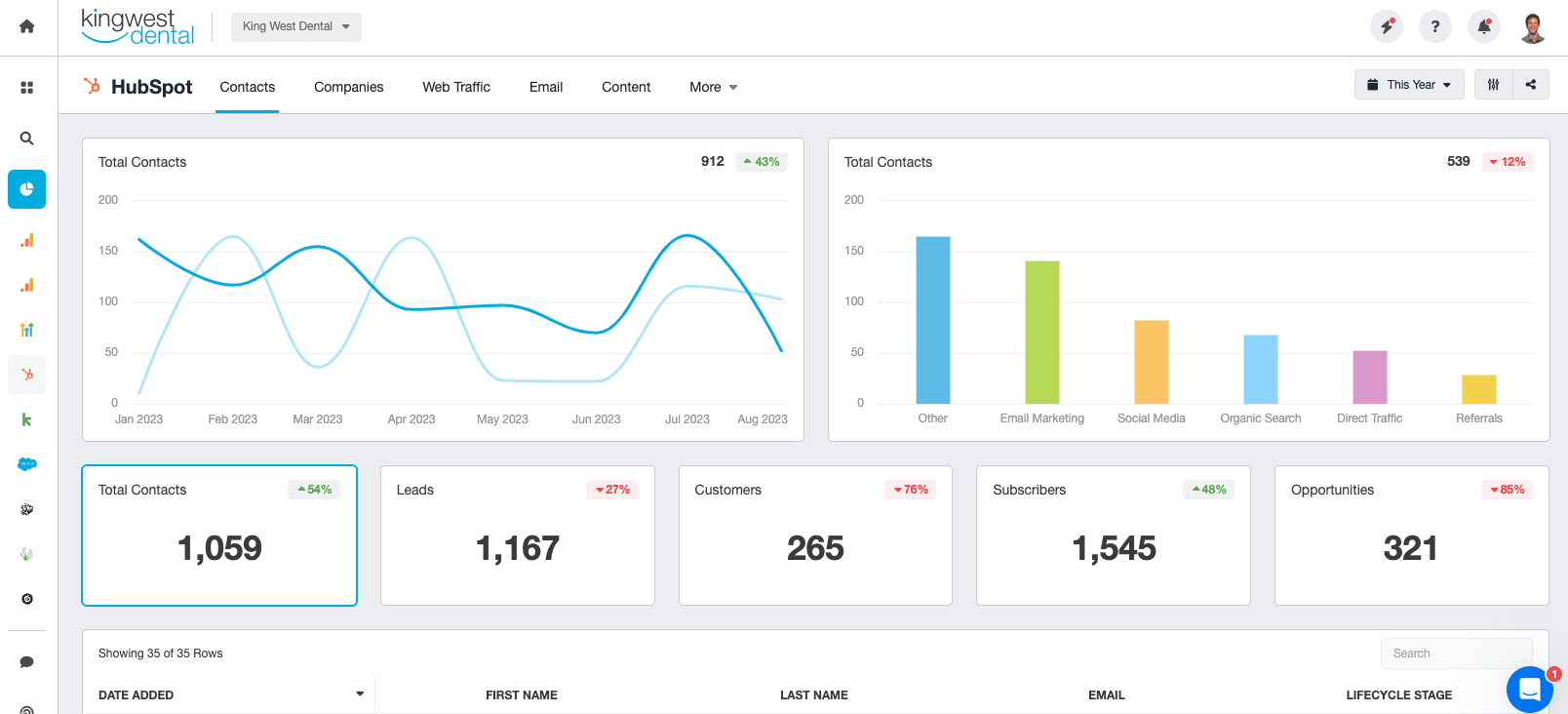
With a reporting tool like AgencyAnalytics, it’s easy to consolidate data across 80 marketing platforms and counting. Sign up for your free 14-day trial today.
3. Scalability and Flexibility
Agency growth comes with increased complexity. New clients and additional team members will need to be accounted for and included in your project management processes as you expand.
That’s why an agency project management tool is important–it complements this growth and lets you scale without constraints. With this in mind, ask the following questions:
Can this tool handle more projects, clients, and team members as our agency grows?
Is it possible to customize workflows and agency processes (e.g., automatically scheduling reports)?
4. User Experience
A well-designed, visual interface reduces internal training time and speeds up onboarding for new team members. Remember to think:
Is this tool intuitive and user-friendly (e.g., it offers effective data visualization)?
Can team members quickly adapt to this tool, or is there a steep learning curve?
5. Collaboration and Communication
With so many clients on your roster, your agency project management tool should offer a streamlined communication feature.
This makes it much easier to liaise with clients, communicate internally, and document all agency-client interactions. When choosing an agency project management software, ask key questions like:
Does this tool allow multiple client and staff logins?
Is there a built-in messaging feature that clients can use to chat with our marketing agency?
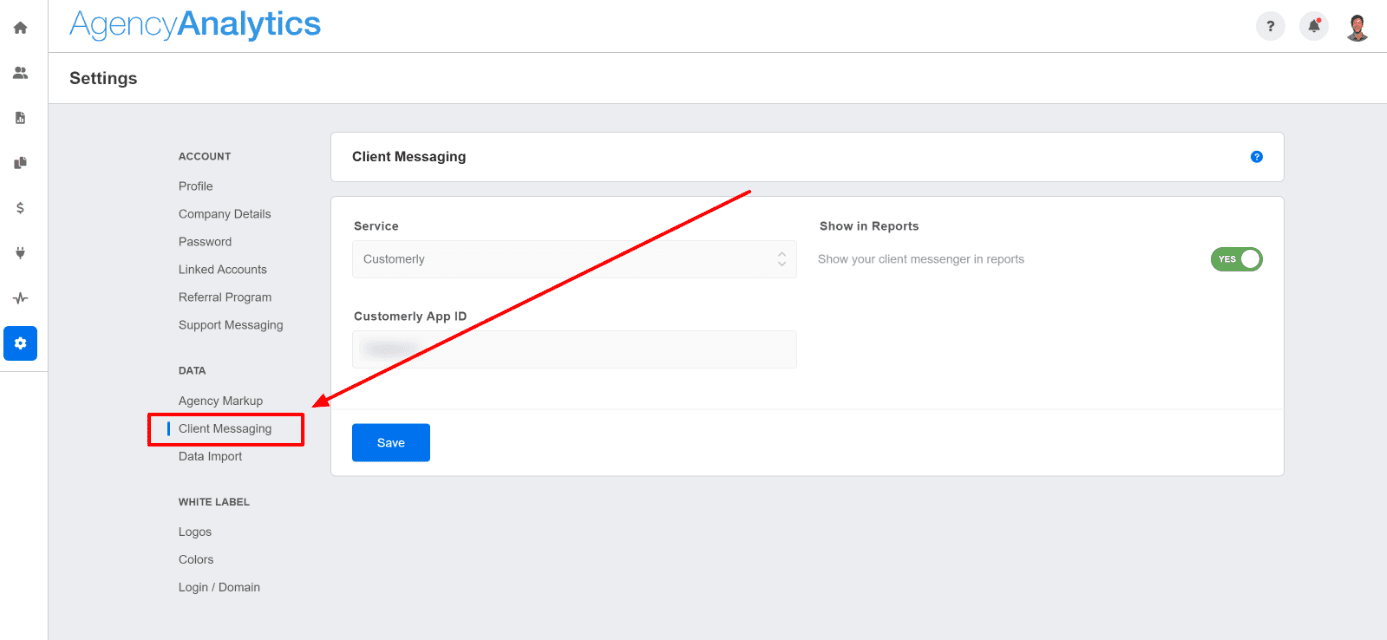
Use a client reporting tool that seamlessly integrates with messaging apps like Intercom, Zendesk, and HelpScout. Explore over 80 integrations on AgencyAnalytics–start your free 14-day trial today.
6. Budget and Costs
Even if you’ve decided on cost-effective agency project management software, it may become significantly more expensive as your agency grows. That’s why it’s essential to keep a future-oriented mindset when making your decision. Be sure to consider the following:
Does this tool’s pricing align with our agency’s current budget?
What are the costs related to upgrades or additional features?
7. Training and Support
Even if you’ve got the best agency project management tool, it only works if you know how to use it.
That’s where proper training and support comes in. Here are key considerations to think about:
Does this vendor offer training or onboarding sessions?
Is there reliable customer support, and what are the support response times?
Are there sufficient online resources, tutorials, and documentation available?
5 Best Project Management Tools for Agencies
Now that you’ve chosen a framework and understand how to identify the right platform, let’s take a look at a few top project management systems.
1. Basecamp
Known for its simplicity and visual interface, Basecamp is a project management software that features to-do lists, milestone management, and file sharing.
This project management tool offers a free 30-day trial, and their basic package then starts from $15/month. Their Pro Unlimited option (ideal for agencies) is priced at $349/month and includes storage space, 24/7 customer support, and unlimited projects.
Basecamp has been very helpful for us as we struggled with transparency with clients. It allows us to create schedules and due dates in an organized structure. Another great feature is its ability to create shortcut links that get added to a client’s project.
Alejandra Villarreal, COO of Website Depot

2. Workfront
Developed by Adobe, Workfront is tailored specifically for marketing teams and agencies. Some handy project management features include goal tracking, task assignment, and Agile work management. This platform also supports other methodologies, like the Hybrid approach.
Custom pricing is available upon request for this agency project management software.

3. Asana
Asana offers streamlined task management, real-time communication with clients, and built-in automation. There’s also a project management tool built specifically for the Agile methodology.
Their free version offers an unlimited number of tasks, projects, and messages. However, agencies may most benefit from their Premium plan (starting from $24.99/month), which includes time tracking, approvals, and advanced integrations.
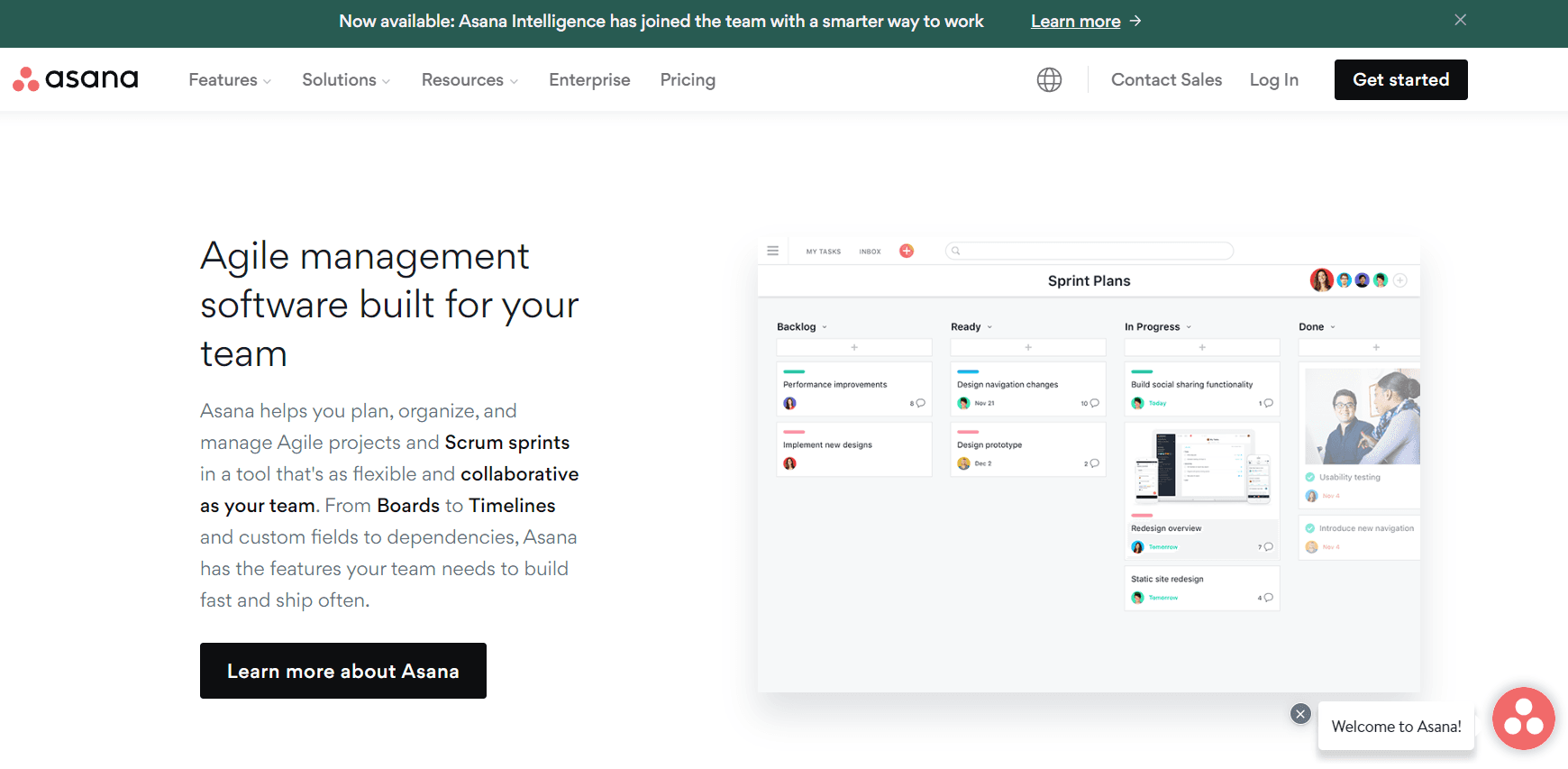
4. Teamwork
Teamwork is a project management software that enables agencies to stay on top of deliverables and demonstrate ROI to clients. Standout, agency-centric features include client portals, calendar integration, and milestone tracking.
While there’s a free version, explore Teamwork’s Grow package ($19.99/month), which offers workload and advanced budget management. If you’re an enterprise-level marketing agency, request a demo for their highest plan (Scale).

5. Notion
Notion stands out because of its unified workspace, which blends note-taking, task management, and databases. Agencies will also benefit from other features like collaborative editing, integrated calendars, and granular permissions.
In addition to its free version, there’s also a Business tier ($18/month) that includes bulk PDF exports and private team spaces. Larger agencies can consider requesting a demo for their Enterprise project management software.

Steer Client Projects to Success With Streamlined Reporting
Project management is a critical, worthwhile investment for all agencies. While executing complex projects, you’ll need a scalable system that lets you monitor your agency’s results and track the team’s progress.
Using a client reporting tool like AgencyAnalytics complements your project management software and provides client performance insights at the click of a button.
We use a combination of platforms. Workfront for task structure and planning projects. Notion for communication and internal team collaboration. AgencyAnalytics for strategic analysis and course correction.
Jordan Jackson, Senior Service Delivery Strategist at OTM
AgencyAnalytics empowers marketing agencies to monitor insights, report on performance, and make any necessary adjustments throughout the project life cycle. The platform features::
Pre-built dashboard and report templates so you don’t have to reinvent the wheel each time
Dynamic goal tracking, which helps you monitor the progress of client projects
Agency-centric, customizable features like:
The ability to build your own dashboards
Drag and drop widgets
Annotations to contextualize data visualizations
Client login access, which enables real-time project tracking and data transparency
24/5 customer support for any additional questions
Invest in a client reporting tool that helps you monitor progress and deliver successful client campaigns. Report smarter, not harder–try AgencyAnalytics today, free for 14 days.

Written by
Faryal Khan is a multidisciplinary creative with 10+ years of experience in marketing and communications. Drawing on her background in statistics and psychology, she fuses storytelling with data to craft narratives that both inform and inspire.
Read more posts by Faryal KhanSee how 7,000+ marketing agencies help clients win
Free 14-day trial. No credit card required.




